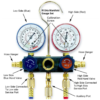Why Don’t They Use Carbon Dioxide in Automotive Air Conditioning?
Everyone appreciates that regulations stemming from environmental concerns has been steering the direction of automotive A/C refrigerants for the past twenty-five years or so. In the 1990s we moved away from R-12, a CFC, in favor of R-134a, an HFC, to help mend the damage the former was doing to the Ozone Layer. Later, in the 20-teens we moved from R-134a to R-1234yf (an HFO) because it did not significantly contribute to global warming.
The environmental standard to which each of these gases has been held is how they compare to the impact of refrigerant grade Carbon Dioxide, or R-744. CO2 is natural and is considered a “climate neutral” refrigerant. It has an Ozone Depleting Potention (ODP) of 0, and a Global Warming Potential (GWP) of just 1. So why don’t auto manufacturers use R-744 in their vehicles instead of always looking for environmentally-friendly alternatives?

As it turns out, the obstacle with CO2 is the pressure under which it operates. The pressures required of CO2 systems is ten times higher than that of R134a! That ultra-high pressure is a safety concern both for techs who would eventually need to work on the systems as well as vehicle occupants in the event of a collision or other impact. In addition, the high pressure of the system also presents a significant engineering challenge which would requires unique components and system layouts.
Instead, over the past several years manufacturers have chosen to transition to R-1234yf. Like CO2 yf also has an ODP of 0 and and GWP of 1, and while it has been designated mildly flammable, it is far less so than most of the other fluids under the hood.
So, in terms of environmental impact as well as the safety of drivers and their passengers, there is every reason to believe R-1234yf will be the automotive refrigerant of choice for a long time to come.
LMK 2021





